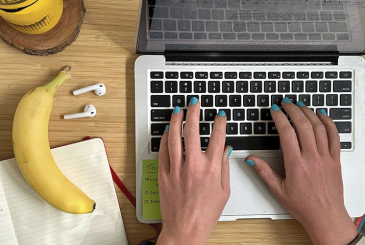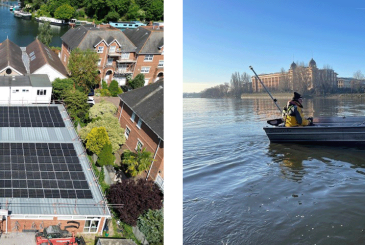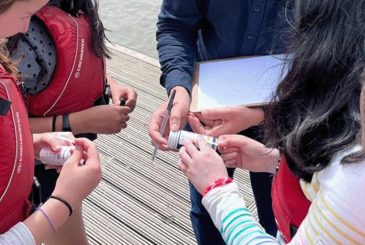World Environment Day is on Saturday 5 June, so Minty Cullinane from Junior Rowing News explores the context of climate change and how, collectively, we can lessen its impact
Protecting our environment can seem an overwhelming task and perhaps a challenge too great for humanity to overcome. But, as a species, we have already come a long way – seemingly, against all odds.
First proposed in 1996, Robin Hanson’s Great Filter advanced a solution to the Fermi Paradox – the baffling realisation that we appear to be alone in the universe. In his essay, he outlined that the only reason that humans have progressed so far is that we have managed to overcome so-called ‘great filters’ that prevent most galactic species from making it to the next rung on the expansionist ladder. Such filters include the evolution of multi-cellular life and the development of complex intelligence. Now, we face a renewed threat – a new great filter – that threatens to end humanity’s dreams of a utopian future amongst the stars: climate change.

Whether we will overcome the challenges posed by pollution and global warming remains to be seen. However, what is certain is that if we want to maximise our chances of helping our planet heal, we must all do what we can to lessen our environmental impact. This begs an obvious question, as rowers, what effect does our sport have on climate change, what will happen if we fail to act, and what can we all do to improve the eco-friendliness of rowing?
Water pollution is one of the greatest threats to competitive rowing
The problem
As with every other slice of modern society, rowing is no longer a zero-sum game. This is hugely beneficial for those looking to find their feet in the boathouse, yet it necessarily implies that the impact of the sport is no longer constrained. Consequently, the number of miles driven and flown to regattas around the world is rising, as is the manufacturing impact of boatbuilders who are keen to capitalise on increasing demand. The gross tonnage of waste generated at clubs and regattas continues to contribute to landfill, whilst the petrol-hungry launches that umpires and coaches utilise continue to guzzle fuel by the gallon.
The above is a somewhat grim outlook on a sport that has a genuinely positive impact on the world through so many means, but we must acknowledge our impact. Indeed, in a recent poll conducted by Junior Rowing News, over 94% of respondents agreed that climate change was ‘deeply concerning’. Yet, we are not only perpetrators of environmental damage, but also victims of it. As seen at the 2016 Rio Olympics, water pollution is one of the greatest threats to competitive rowing. In a wider sense, a recent paper published by Cambridge University suggests that climate change may have driven the emergence of Covid-19, although further research needs to be undertaken to establish a causal link here.
Perhaps the most chilling realisation of the impact of climate change on sport is the effect on athlete physiology
A dystopian prediction
Sport 2050 is a collaborative project between the BBC and the Met Office that aims to raise awareness of the potential future impact of climate change on sport. The team behind the publication envisage a world in which winter sport relies on fake snow, golf is without grass, and almost every sport has its share of competitions called off due to extreme heat and storms.
Perhaps the most chilling realisation of the impact of climate change on sport is one firmly grounded in today’s science: the effect on athlete physiology. As mammals, we have evolved sophisticated feedback mechanisms that closely monitor and regulate our core body temperature, and in most environments, these mechanisms work well.
However, as soon as the ambient air temperature exceeds that of the skin, normal thermoregulatory processes such as sweating and peripheral vasodilation cease to be effective. These devices rely on radiation and evaporation of water down gradients which no longer exist once the air reaches a critical temperature of around 40℃. As a result, sweating at very high temperatures simply compounds dehydration and warms the body further. At this stage, hyperthermia (as opposed to hypothermia) becomes an emergency that can be fatal, if left untreated. Heat stress is a condition that already bedevils sports and will only become more prevalent as global mean temperatures continue to rise.
Many rowers have suggested beginning a transition to electric launches
A solution?
We reached out to you, the rowing community, for your ideas on reducing our collective impact and preventing a grim scenario such as the one above from becoming our reality. Before we dive in, it’s important to stress that anything you can do to lessen your impact on the environment throughout your day-to-day life will help, and the ideas below are just some of the things you and your club can do around the river.
Around 21% of total global emissions each year are caused by vehicles, and whilst an admittedly small fraction of that is linked to movement associated with rowing, there are nonetheless actions we can take. For example, many rowers have suggested beginning a transition to electric launches. Our catamarans are well-suited to electric power and are already in use for numerous regatta operations, as well as camera platforms for TV coverage at events such as Henley Royal Regatta. In a similar vein, minimising the time spent travelling by car and cycling or walking instead, and carpooling when long-distance transport is required will reduce net emissions.
Switching to reusable water bottles is a simple action we can take to decrease our pollution of the rivers. It incentivises us to take better care of our canteens, not to mention the reduction of plastic that ends up in landfill.
National Schools’ Regatta has already enacted an embargo on non-reusable bottles at their events and encourages the use of Tupperware to help minimise food waste. You could also try to cut your meat consumption or even transition to a plant-based diet to reduce the impact associated with meat production. If you’re a high-performance athlete, make sure to liaise with support staff and coaches to make sure you’re able to pull all the nutrients you need from your new diet.
Here are some ideas from the United Nations Regional Information Centre’s interns about how you can be part of #GenerationRestoration…
Nothing outlined above is a solution to climate change, but as a collective, our actions can help restrict the damage inflicted on the environment. There are advancements being made towards a net-zero future; we should be quietly optimistic.
In his book, The Selfish Gene, Geneticist Richard Dawkins unwittingly discussed one of the first great filters we faced as a species – the emergence of the ‘first replicator’ – a biological machine that evolved from nothing but dead chemistry around four billion years ago, giving rise to all the life we see today. This process is widely considered the biggest challenge in the evolution of complex life, and is believed by many to have occurred due to nothing more than chance.
Combating climate change often seems to be an impossible task, but we have an advantage over those early replicators; we don’t have to rely on a mere roll of the dice. Instead, as rowers, we can harness the power of an ideological revolution that’s already in progress to catapult our sport to the front of the fight against climate change, setting an example for our peers, children and grandchildren.
For more articles on the environment and climate change, why not read GB rower Melissa Wilson’s thoughts here.
Illustration: Simon Wild










